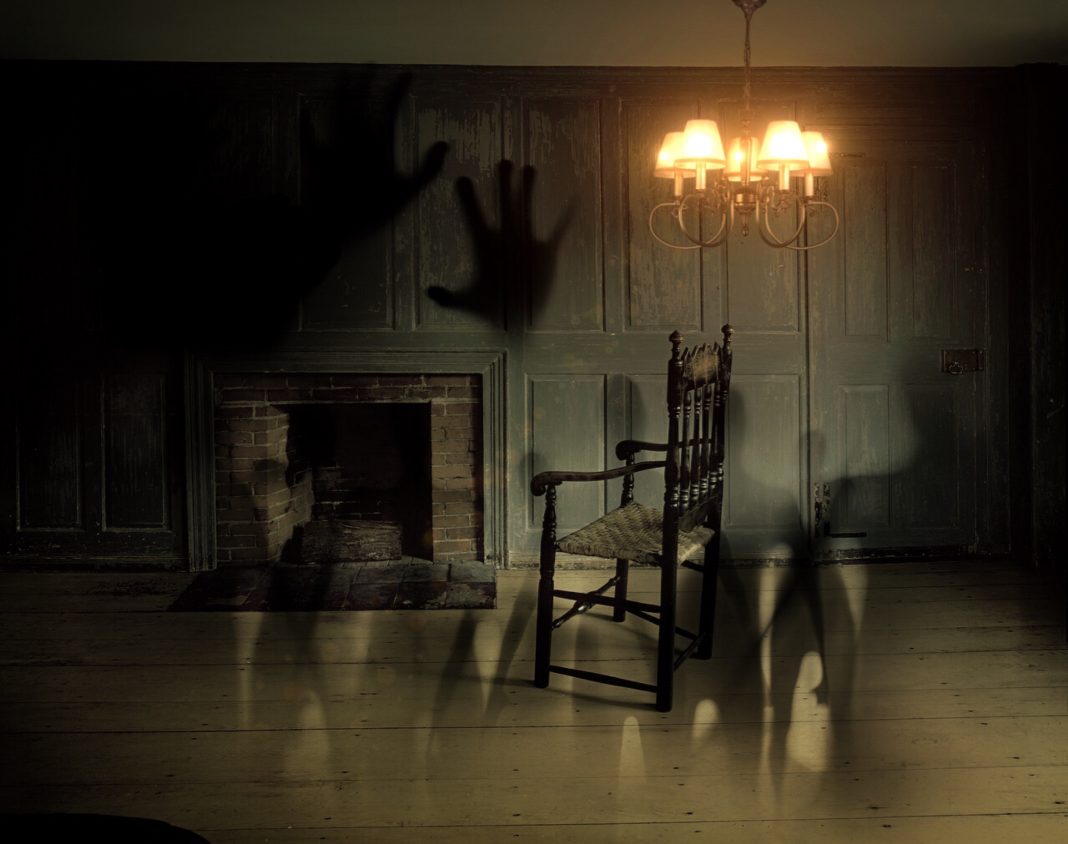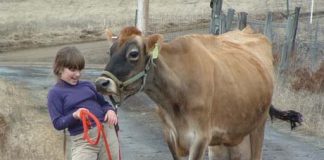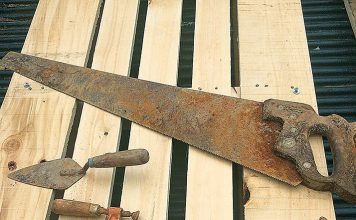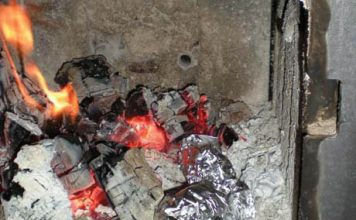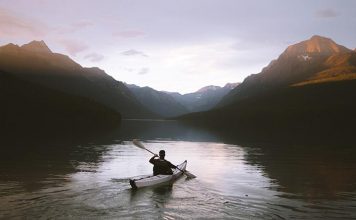 |
|
| Issue #134 • March/April, 2012 |
“Can you survive a zombie apocalypse?” a familiar voice asked.
I turned in my seat to see O.E. MacDougal, Dave Duffy’s poker-playing friend from Southern California, walking toward me. Dave, of course, is the publisher of Backwoods Home Magazine.
I hadn’t seen Mac in a long time.
“How are you doing?” I asked.
“Oh, just dandy.”
“Zombie apocalypse?” I asked.
“Yeah, Dave said you guys are doing a theme issue that’s sort of a preparedness issue if the fertilizer hits the fan.”
“We are,” I said.
“He says you’re writing about how the world can end.”
“Yeah, but what’s there to write about? How many ways can it end?”
“Lots of ways, but the first thing you have to do is qualify it. When we talk about the world ending,” he said, “we usually mean civilization-crippling events, although I guess some scenarios could really ‘end the world’ or at least drive the human race into extinction.”
“I suppose you’re right,” I said.
“End-of-the-world scenarios are fun to think about.”
“Fun?”
“Of course. That’s why every time an apocalyptic date passes, we jump on a new one. Y2K, Planet X, the Mayan calendar there’s no end to them, and there never will be.”
“But none of them are realistic,” I said.
“Actually, some are,” he said.
I looked at him obliquely.
“I’m not kidding,” he said. “There have been catastrophic events in the past that, if they happened today, would be the end of life as we know it. I’m not talking about local events, like great earthquakes or even a volcano the size of Mount Tambora in Indonesia, which, when it erupted in 1815, changed the earth’s climate for several years so that it even snowed in New England in June of 1816. In fact, it snowed in Europe the same summer. It changed the earth’s climate long enough for crops to fail all over the world, causing famines.”
“Oh, yeah,” I said. “You talked about that, and I wrote about it, way back in the early days of the magazine.” (See “The summer it snowed” in The Best of the First Two Years Anthology.)
“You’ve written about a bunch of global disasters in the past,” Mac said. “Maybe, given the focus of this issue, it’s a good time to revisit them … and include a few others you’ve never written about before because some of them, if they happened today, you and I probably wouldn’t survive.”
Now he had my attention.
|
Supervolcanoes
“For example, if you’re close to any one of the world’s supervolcanoes when it goes off, you’re a goner. It’s that simple. Of course, there may be plenty of warning when one’s going to blow its cork and you may be able to get out of its way but you’ll have to get way out of its way and, even though you may survive the immediate catastrophe, you may not survive the aftermath.”
“Can you give me an example?”
“Sure. You’ve written about the supervolcano under Yellowstone National Park.” I nodded and he continued, “At its widest point, its caldera is something like 45 miles across. In the past it’s erupted, on average, about every 600,000 years, and the last time was 640,000 years ago.”
“So we’re due,” I said.
“It’s going to go off at some point. Maybe this year; maybe 100,000 years from now. We don’t know enough about them, yet. But we do know, from the geologic record, that if it’s a full eruption, just about everything living within a 600-mile radius will get killed by lava, ash, poison gases, or the explosion itself.”
“How far away are we from it here in Oregon?” I asked.
“As the crow flies? About 700 miles. Far enough that you’d probably survive the immediate eruption. You’d have to worry about the aftermath.”
“What happens then?”
“The prevailing winds would carry trillions of tons of ash across the continent toward the East Coast. On its way it would bury farmland in the Midwest and clog the cities in the east, fouling the air so they could barely breathe it. Planes wouldn’t be able to fly since their engines would get clogged and I doubt cars and trucks would get far before their air filters clogged.
“Do you remember images of scenes in cities in the Northwest after the eruption of Mt. Saint Helens in 1980 where photos taken at high noon looked like midnight scenes in a snowstorm as falling ash blocked sunlight as it fell to earth. Scenes will play out like that for weeks and perhaps months on the East Coast.”
“But we’re west of it, so we’re in the right place,” I said.
“Maybe. The full eruption of any of the supervolcanoes is going to be a global catastrophe. The stuff that gets thrown in the air will block sunlight as it circles the earth and, from what I’ve read, mean temperatures in the northern hemisphere will likely drop by at least 9 degrees and perhaps as much as 27 degrees.
“Want to see climate change? When the supervolcano beneath Lake Toba in Indonesia erupted 74,000 years ago, it may have brought the human race as close to extinction as it’s ever come. Some scientists think it deepened the Ice Age that was already going on, and made it worse for about a thousand years. Its effects may have reduced the human race by 40 percent, and some scientists think it reduced it to where there were only about 10,000 people left on the entire planet.”
“You said the eruption of any supervolcano …”
“There are others around the globe,” Mac said. “All of them will present future problems.”
“Where are they?”
“Besides Yellowstone and Lake Toba, there’s one beneath Lake Taupo in New Zealand, one in Japan, one in California, one in New Mexico, and there are probably others around the world, and every few hundred thousand years or so they go off with an eruption that alters the world’s climate.”
“Really?”
“Yeah. But in the distant past there have been even bigger and fiercer volcanoes that were larger than any of the supervolcanoes we know of now, and were one like those to erupt now, whatever survived of humanity would be back in the Stone Age.”
“Is this a joke?”
He shook his head. “The biggest one we know of happened about 252 million years ago. It’s associated with the Permian-Triassic extinction when roughly 96 percent of all species on this planet disappeared. What’s left of that eruption, today, are called the Siberian Traps. That eruption went on for a million years, changing the world’s climate and wiping out most of the life that then existed on this planet.
“Other supervolcanoes may have brought about extinctions, too. Though many scientists believe the dinosaurs made their exit because of a huge asteroid or comet hitting the earth 65 million years ago, there are others who believe it came about because of massive volcanoes that formed the Deccan Traps on the Indian subcontinent.”
“Were they like the volcano in Siberia?” I asked.
“Not as big, but bigger than anything since.”
“What do you think wiped out the dinosaurs: Volcano or an asteroid?” I asked.
“More likely an asteroid or comet, but coupled with the volcano, it would have been a devastating one-two punch to life on earth.”
“What are the chances of one of the supervolcanoes going off today?”
“I once read that we can expect a large supervolcano eruption every 100,000 years or so. But they may happen twice as often and some other volcanoes may still erupt with smaller, but still civilization-rocking eruptions, every 5,000 years or so.”
“Smaller?”
“Yes,” he said, “like Tambora, maybe bigger.”
“That’s the one that caused the year without summer,” I said.
He nodded.
“What else can go wrong?” I asked.
|
Dawn of another Ice Age
“If you want to hear more, we currently live in the interglacial period of an ice age. I know, the environmentalists are saying we live in a time of global warming, and they may be right. But that’s uncertain. What’s for sure is that we’re living in a warm period, what’s called an interglacial period, of an ice age.”
“Says who?”
“Climatologists.”
“Why do they say that?”
“Because for most of the last half billion years, the earth has been warmer than it is right now. In those warmer times there were no permanent glaciers on Greenland or Antarctica. The fact that they exist in those places today is, to them, a clear indication we’re still in an ice age. And here’s the capper: If the ice age is now ending, global warming is inevitable and there’s nothing we can do to stop it.”
“In other words, if it’s ending, the world would get warmer even if there were no people,” I said.
“That’s right. But, let’s assume it’s not ending and the ice is going to start growing, again. What does that mean for you?”
“I don’t know, but you’re going to tell me, aren’t you,” I said.
He smiled. “When we were kids, our teachers used to tell us that the glaciations began and ended over so many centuries that no one who was alive when a glacial period started or ended would live long enough to see the change. So, they would be unaware of the change.
“But, what we’ve learned since is that these glacial epochs begin and end with an abruptness that’s frightening.”
“I know,” I said. “It was one of the things I researched for my novel, Danielle.”
Mac nodded once, as if I should go on.
“The geologic evidence shows that at the dawn of the last glacial epoch, much of what is now Great Britain went from a temperate climate to being buried under 100 feet of ice in less than 20 years. And, when it ended 100,000 years later, or about 12,500 years ago, the two-mile thick sheet of ice covering what is now the American Midwest disappeared in as little as five years. It’s the reason I chose to make an ice age the driver in my own survivalist novel. If a glacial period starts in our lifetimes, it’ll happen fast, stop civilization in its tracks, and billions will die.”
“Sounds like you did your research,” Mac said. “You know,” he added, “I remember the unseasonably cold weather we’ve had the last few winters. There were record lows all over the country and in many other parts of the world. I’ve been thinking that if it’s actually an ice age that’s starting now, we’re going to be burning our Speedos and bikinis to keep warm.”
I don’t know why I found that funny, but I did, and even Dave, who I didn’t realize had come into this part of the office, was laughing.
“Give me another world-ender,” I said.
|
Pandemic disease
“Disease,” he said.
“Pandemic,” Dave said.
“Yes. We can talk about the Black Death when it swept Asia and Europe, or the Spanish Influenza that spread around the world almost a century ago. But a better example of contagions obliterating a population is the wave of diseases that swept North and South America starting in 1492, when Europeans inadvertently brought their microbes here.
“Once again, when we were kids, we learned that, with the exception of the Incas in the Andes and the Aztecs and others in Mesoamerica, the New World was hardly settled at all. Now, we’re learning that that’s not true. New evidence, both archaeological and historical accounts written by European explorers of the time, indicates that between North and South America there were as many as 100 million Indians.
“Not only were there more here than we were told, they left evidence because they had molded the continent to their liking. Indians, millions of them, sculpted their world with fire. They kept vast tracts of open land and burned their fields annually to stop the forests growing.”
“Why?” I asked.
“To promote grasslands, which drew game. Forests were much harder to live in. Open fields, however, drew deer, elk, bison, and a host of other game animals. Accounts of early settlers included the magnificent prairie fires the Indians would set in the fall so that, in the spring, game animals could thrive on the new growth. In fact, when the first Europeans arrived, there were buffalo in Virginia, Pennsylvania, New York, and other places where they became extinct only because the Europeans let the forests grow back. The earliest British settlers said they could ride in carriages or on horseback for miles with no impediments. But by the time of the Revolutionary War, the vast fields were gone because those millions of Indians who had preceded the Europeans no longer kept the forests at bay, and the grasslands they had maintained for thousands of years were taken over by the forests. By some estimates, 90 to 95 percent of the Indians had died by then. There’s a great book called 1491: New Revelations of the Americas Before Columbus, by Charles Mann, that explains it all.”
“How does that relate to ways the world could end?” I asked.
“Fast-forward to today, an age of antibiotics that is forcing microbes to evolve into resistant strains to which we, like the Indians of 1492, would have little or no resistance at some future date. There would be no effective antibiotics because they’d have evolved to be immune to what we have. It’s possible we wouldn’t be able to produce vaccines against them either. Then factor in the possibility that we are on the brink of manufacturing deadly, contagious microbes in the lab, and you can see the picture I’m painting.
“Just recently, Dutch scientists reported they’ve engineered a mutated form of the H5N1 flu virus, by simply creating five mutations on two of the virus’s genes. This new virus is both more virulent and contagious than any previous forms we’ve seen.”
“Then it’s just a matter of time before other scientists in other laboratories either duplicate the feat or create strains of their own,” Dave said. “Not just of influenza, but other diseases, as well.”
“That’s right,” Mac said. “Terrorists with new deadly microbes could do more to bring down the West with engineered microbes than they could with a couple of nuclear bombs.”
He looked down as he thought a few moments. “Expect a good chance of seeing biological weapons deployed in our lifetime.”
I told him about one of the books I’m reviewing for the next issue. “In his book, Rohan Nation: Reinventing America After the 2020 Collapse, Drew Miller creates a scenario where several strains of mutated viruses are unleashed upon the world and kill billions.”
“I haven’t read it,” Mac said. “But 10 years ago, I’d have said it was a science fiction scenario. Today, a novel like that may be prophetic.”
“Those who engineer deadly viruses might also be able to engineer vaccines against them before they unleash them,” Dave said.
Mac nodded and added, “Too bad you won’t have any.”
The three of us laughed uncomfortably.
“Remember though,” Mac said. “we have one piece of information that Europeans, at the times of the great plagues, and the Indians of North and South America didn’t have, and that’s sanitation. A germ theory of contagious diseases simply did not yet exist back then. Today, however, we know pretty much how disease is spread, and sanitation, as well as isolation, will work in your favor.”
“You mean we can survive it?” I asked.
“We might. But, if you knock on my door during a deadly pandemic, one sneeze and you’re toast.”
Dave and I laughed, again.
“But sanitation or not,” Mac continued, “in the time of a pandemic, the kind the Indians of North and South America experienced, don’t expect food to be reaching the stores, don’t expect gasoline to be reaching the gas stations, and don’t expect treatment from an overburdened health industry. Western civilization all civilization will be brought to a crawl.”
“What are the chances?” Dave asked.
“A dozen years ago, I think I said the chances were one in six of a worldwide pandemic that could shake civilization to its core.” He inhaled in and let out a deep breath. “I think, now, the chances are at least twice that. I’d say at least one in three. Maybe worse.”
“Fill your larders, now,” Dave said. “We’re knee-deep in extinction events!” he added.
“Yeah,” Mac said. “And something to keep in mind is that the big extinction events were probably caused by big events, like the ones at the end of the Permian or Cretaceous periods. In other words, huge volcanoes and huge cosmic impacts caused more extensive extinctions, but there are a lot of lesser extinction events that were probably caused by eruptions and impacts that still had global consequences. Though the human race would likely survive one of them, any one would cripple civilization for years or decades and may even be enough to make nations desperate enough to precipitate a nuclear war.”
“So even a lesser event, as you so euphemistically describe it, could bring us down,” I said glumly.
“Oh, yeah!”
“This is where the acronym TEOTWAWKI applies,” Dave said.
“That’s right,” Mac said.
“What’s that mean?” I asked.
“The end of the world as we know it,” Dave said.
“Oh.”
|
Cosmic impacts
“What about cosmic impacts?” I asked.
“Another way the world has apparently ended before has been by cosmic impact,” Mac said. “It’s thought by many scientists that the demise of the dinosaurs, in fact, the extinction of about 75 percent of the species that existed some 65 million years ago, came about as the result of an impact by a six-mile-wide asteroid.”
“I know about that,” I said. “What are the chances of another one?”
“There are asteroids that cross the earth’s orbit as we go around the sun, but as far as we know, none of the really big ones are on a collision course with us. What we know less about are comets. First, there may be long-period comets coming back toward the sun that we don’t know about because their periods are so long, in the thousands of years, so no one in recent history has seen them. The other danger is that the way we usually see comets is by their comas, the frozen gases and ice that boil off their bodies as they get closer to, and get warmed by, the sun. But each time one passes, it loses more of that stuff and on the next orbit, all that might be left may be a rocky core a huge rocky core. That means one coming back like that may be invisible to us, until it’s too late.
“But the real problem with a comet or an asteroid is that, even if one was barreling toward us, right now, and we saw it, and we had five years of warning, it’s likely that, in spite of movies like “Deep Impact” and “Armageddon,” where the heroes save the day, there’s actually nothing we could do about it. Not today, anyway. And even if someone could come up with a realistic plan, the later we detected it, the less chance there is we could do anything to stop it.”
“How much damage would one of those do?” I asked.
“The damage would depend on the size of the comet or asteroid. It’s estimated that the body that ended the reign of the dinosaurs was about six miles wide. It struck with the force of close to 10 billion Hiroshima-type nuclear bombs. The kinetic energy released when one hits depends on both its mass and its velocity the formula is the famous F = mv2, which we should have learned in high school physics. Just for the sake of argument we’ll assume they’re all roughly spherical with the same density and moving with the same velocity. So one that was about 15 to 30 feet wide would enter the atmosphere with force in the range of the atomic bomb that we dropped on Hiroshima in World War II. One of those enters our atmosphere about once a year and they usually blow up in the upper atmosphere and go unnoticed, especially when it happens over the ocean. However, now and then there are witnesses to one.
“Bigger ones carry more energy, but they’re also rarer. A 300-foot wide one would have 1,000 times the mass of a 30-foot one and would release 1,000 times as much energy as the Hiroshima bomb; about as much as a 100-megaton bomb, which is twice as much energy as was released by the biggest bomb ever detonated. But even that would only cause local effects. The Tunguska event, a huge meteor that blew up over Siberia in 1908, leveling thousands of square miles of trees, was probably only 200 feet wide. But even one that size, exploding over a city, would destroy it.”
“And how often do those hit?” Dave asked.
“Objects larger than 300 feet in diameter and up to 3,000 feet in diameter probably hit about once every 5,000 years, with the larger ones only hitting maybe twice in a million years. The 3,000-foot ones would destroy many countries and cause short-term climate changes. Globally, millions would die because of the effects on agriculture.”
“Bigger?” Dave prompted him.
“One more than 3,000 feet wide and up to 30,000 feet would have devastating consequences. The one thought to have caused the extinction of the dinosaurs was a 30,000-foot monster. That’s six miles across. It created the Chicxulub Crater that’s partly in Yucatán and partly in the Gulf of Mexico. And do either of you remember the Shoemaker-Levy 9 comet that hit Jupiter in 1994?”
“That’s the one that broke up as it approached Jupiter and the press called it the ‘String of Pearls’ comet because it hit the planet in pieces,” Dave said.
“I’m glad you remember because scientists are finding more large impact craters that formed around the time the one that hit Mexico did.”
“So they’re thinking there may have been more than one,” I said. “Large chunks of the asteroid may have fallen all over the earth.”
“That’s right, and if a similar event happened, now, what was left of the human race would be thrown back into the Dark Ages. The only thing we’d have going for us is that the survivors would know a modern world is possible to build again, and the survivors might rebuild much of civilization in a few generations.”
“So, even if the three of us survived the impact, we’d never see a modern world, again, though our great-grandchildren or great-great-grandchildren might.” Dave said.
Mac nodded his answer, again.
“Any bigger ones?” Dave asked.
“Though the Permian extinction is now thought to have been caused by the volcanoes in Siberia, if it was caused by a cosmic collision, it would’ve been a much bigger impacting body than the one that ended the Cretaceous, which marks the end of the dinosaurs’ reign. And I’m sorry to say, but one that could have killed off 96 percent of all species might obliterate humanity, and one larger almost certainly would.”
“Wow!” I said.
“Some scientists believe that the Bedout High geologic feature, a huge, ancient crater in northwestern Australia, may be the impact site of a body that ended the Permian.”
“And, of course, there may have been more than one,” Dave said.
“What are the chances of another one?” I asked.
“Astronomers currently feel that the chances of the destruction of civilization by cosmic impact is about one in 50 million in any given year.”
No one said anything for a moment.
Carrington event
“Another possibility of a world-ending event is a huge solar storm that causes an electromagnetic pulse, or EMP.”
“A Carrington event,” Dave said.
“Yes,” Mac said. Then he looked at me and said, “You just did an article on EMP in Issue 132 (November/December 2011).”
I nodded.
“You said there’s a possibility for a major solar storm on the sun to produce solar winds of such intensity that they’ll distort the earth’s magnetic field and, when the magnetic field tries to regain its shape, it’ll create an EMP that could wipe out modern civilization. Unless we’re prepared for it, that pulse could destroy the electric grid, worldwide, and it could be years or even decades before we recover. In this case, it isn’t the solar storm that will kill you, it will be, as you said in your article, the aftermath. With the destruction of the transformers at the power plants, there’ll be no way to get the grid back up for years. That means food, fuel, and medical help will be interrupted for years. The number of people who would die as a result would be staggering, and since our government’s reaction to every emergency is to build more bureaucracy and relieve us of more of our rights, it’s very likely to result in a government that’s more intrusive and more oppressive than ever.”
“What are the chances of a Carrington event happening?” Dave asked.
“Some scientists say a Carrington event occurs roughly every 500 years. But the chances are not one in 500 in any year because the sun runs through a cycle of solar maximums and minimums and we won’t see a Carrington event during a minimum. But I’d say there’s a pretty good chance we’ll see one happen during the solar maximum we’re going into in 2012-13.”
“How much of a chance?” I asked.
“At least 10 percent, maybe as high as 20 percent. Since we’re guessing, let’s cut it down the middle say 15 percent in the next 40 years with the next year or two being particularly dangerous. If we’re not ready for it, in other words, if we don’t ‘harden’ the 370-plus transformers in this country, we’re going to grind to a halt.
“Any other doom and gloom?” I asked.
|
Black holes
“Black holes,” Mac said.
I hadn’t expected an answer. I didn’t even want one. I was hoping he was done.
“There would appear to be two kinds of black holes to worry about,” he began. “The first would be a black hole that’s wandering toward the earth from outer space. One of those could be nasty.”
“What are the chances?” Dave asked.
Mac grimaced and looked at the floor. When he looked up again he said, “I’m going to go out on limb and say pretty much zero.”
“Why?” I asked.
“Because there don’t appear to be any in our solar system and we don’t see any other kinds of objects moving into our solar system, so I’d have to conclude black holes won’t either. Celestial mechanics is pretty humdrum. Things don’t wander around haphazardly, they pretty much follow in their boring orbits.”
“What about comets?” I asked.
“They’re part of our solar system; they just originate further out.”
“Oh.”
“But there’s another kind of black hole. Some people are afraid black holes may be created by the Large Hadron Collider now operating near Geneva, Switzerland,” Dave said. “There were even people filing lawsuits to stop its operation.”
“That’s even closer to zero than an extraterrestrial one coming to get us,” Mac said.
“How can you be sure?” I asked.
“The earth is constantly bombarded by trillions and trillions of high-energy particles, every day, in the form of cosmic rays. Some of them are apparently 10,000 more energetic than what the Large Hadron Collider is capable of. The difference between those particles and the ones the LHC creates is that the latter particles are controlled by man. So, if the LHC were capable of creating black holes that could destroy the earth, it would have happened billions of years ago because of cosmic rays that are constantly hitting our atmosphere and you wouldn’t be reading this, now. In fact, there’d be nothing visible left in the universe because all the stars and all the planets would, long ago, have been reduced to black holes.”
“So, that concludes the list,” I said.
Gamma ray burst
“No. We could meet our demise by way of a gamma ray burst.”
“A what?” I asked.
“They’re high energy gamma ray impulses. Most are generally thought to be caused by the collapse of certain massive stars, but there may be other causes, too. But whether the star collapses or some other mechanism, a gamma ray burst, also called a GRB, releases as much energy in as few as two seconds to somewhat over forty seconds, as our sun will release in its entire 10-billion-year life. And it’s the way it releases it that’s interesting. The energy is emitted from the star’s north and south poles in beams, or cones, of radiation. If our planet lies outside of that expanding cone, the radiation will pass us by and we’re safe. However, on the off-chance that one of the beams is pointed our way, and the source is close enough, it could vaporize everything in its path. How close? About 200 light years. Thankfully, there are no candidate stars that close to us. However, even more distant sources may disrupt our planet if we’re in the path of one of its beams.”
“Have we ever been hit by one?” I asked.
“Actually, the earth is in the paths of a few of these every day. But they come from distant galaxies, so energy has dissipated so much that the burst goes unnoticed, except by scientists who study these things. However, some extinction theories say that, in the past, we’ve been in the path of one of those beams whose source was close enough to affect life on this planet, on the average of every five million years. The intensity of our exposure from those bursts would have depended on how far away from the source we were. The closer they were, the more damage they did.”
“What’s the danger if it’s not close enough to vaporize us?” Dave asked.
“A 10-second-long burst, if close enough, could kill almost everything on the side of the planet facing the star. Further, it could alter the composition of the atmosphere, obliterating the ozone layer which would allow the cosmic rays that are constantly bombarding the upper atmosphere to reach the ground. That would be the equivalent of radiation exposure to almost everything on our planet. Furthermore, the burst would have enough energy to combine the oxygen and nitrogen in our atmosphere to form nitrogen dioxide, which would cast an ugly pall over the entire planet preventing much of the sunlight we now receive from reaching us. This would interrupt photosynthesis and bring on mass extinctions including, quite possibly, that of mankind itself. All of this is, of course, just best-guess scenarios.”
“Best guess?” I asked. “You mean, ‘worst guess.'”
He smiled and said, “Some scientists think a GRB may have been responsible for the Ordovician extinction of 440 million years ago, when about 70 percent of all species died off. Other scientists think a GRB from just the right exploding star, tilted just the right way, and just close enough to the earth, might happen about once in a billion years. So, maybe that’s what ended the Ordovician or maybe it didn’t. In the future, expect scientists to uncover evidence that lends credence to this Ordovician scenario or debunks it. But even if it turns out to be untrue, there are scientists who feel GRBs can still be dangerous to us.”
I nodded.
“As a side note,” he said, “I have to tell you there is a binary star system, called WR 104, about 8,000 light years from us.”
“That’s pretty close,” Dave said.
“On an astronomical scale, yes it is. Both of the stars are massive and will, someday, become supernovae. One of them, when it goes bang, will be a sight to behold. If humans are still around, we’ll probably be able to see it during the day. But it probably won’t harm us.
“However, the other star is what’s called a Wolf-Rayet star, named for a pair of 19th century astronomers who first observed this type of star. Stars like this are thought to be capable of creating a GRB when they explode and, if the poles of this one are tipped the right way, we may be right in the way of its GRB.”
“Are we?” I asked.
“Some astronomers who have examined the way the disk of gases rotates around the Wolf-Rayet component of the system, think it is pretty much pointed at us, but it’s too close to call. When it goes off, it may barely miss us. On the other hand, it may fry us. I’ll let you know when I learn more.”
“So, how long before it explodes?” Dave asked.
“We don’t know enough about them to tell. It could be thousands or tens of millions of years from now. Of course, since it’s 8,000 light years away, and it takes 8,000 years for light from it to reach us, it may already have exploded thousands of years ago and when you wake up tomorrow morning…
“Nah! Don’t even think about that one.”
“I’ll be awake, tonight, thinking about it,” I said.
“How common are GRBs?” Dave asked.
“As I said, astronomers detect GRB events every day, but it’s only because there are hundreds of billions of galaxies in the universe and they can usually detect one going off somewhere in the universe. But to give you an idea of how rare they are, astronomers have not witnessed one going off in our galaxy … yet. It’s thought that there are only a few stars that undergo this phenomenon, in an average galaxy, maybe one in a million years. Of course, as we learn more about these events, all of this data is subject to change. They may be more common or less common. But, given how infrequently they happen, and the unlikely case that we’d be in one’s path if it did go off, I’d say the odds of it happening are so remote, I’ve decided not to lose sleep over it.”
“John loses sleep over almost everything,” Dave said.
Runaway greenhouse effect
“Before we finish, I’ve got to add a runaway greenhouse effect to the list of disasters that could befall us,” Mac said, “because it’s what some of the environmentalists are predicting.”
“Runaway greenhouse effect?” I asked.
“It’s what Venus has. Some scientists think Venus may once have had oceans, like the earth has. They think accumulations of carbon dioxide and water vapor in its atmosphere started a runaway greenhouse effect that fed on itself until, today, the temperatures there are more than 800° F. The climate change crowd has warned that, if we keep pumping carbon dioxide into the atmosphere, it’s going to happen to us.
“But there are problems with this scenario. First, there’s no certainty global warming is happening. Second, if there is, whether there’s anything we can do about it. Third, at times the world has been much warmer than it is today, and evidence is that there had been as much as 20 times as much carbon dioxide, some millions of years ago, but there was no runaway greenhouse effect then. So, at the moment I’d have to say the runaway greenhouse effect is more in the realm of science fiction and politics than hard science. It’s not anything I’m going to worry about tonight. I’ll let John lose sleep over it.”
“Anything else?” Dave asked.
|
Nuclear war
“One of the ways the world has not ended before has been nuclear war. Though the chances of a nuclear war may have been reduced since the end of the Cold War, it still exists. The funny thing is, almost any of the civilization-ending scenarios we’ve talked about, so far, could lead to nuclear war. Desperate times will lead to desperate people and it can also lead to desperate political leaders. Food shortages caused by any of the potential natural disasters we’ve mentioned, or a foreign country unleashing a pandemic on the world, might lead to a nuclear exchange that could cripple civilization.”
“Let’s do things the way we did them in that previous column where you projected the chances of a global disaster over 40 years,” Dave said. “What do you think the chances are of an all-out nuclear war in that time?”
Mac thought. “All-out? I’d say the chances of an all-out nuclear war have gone down some, but they’re still there. Five percent, but that’s because I’m an optimist.”
“What about the so-called Mayan calendar prophecy?” I asked.
“Zero,” he replied.
“So, what are the chances of any of these scenarios happening?” Dave asked. “In John’s article titled ‘The Chances of Global Disaster’ (it’s in The Tenth Year Anthology), you gave estimates of what the chances of various catastrophic scenarios were, then you kind of pooled them together and came up with a figure for one or more of them happening in the following 40 years. Can we do that, again?”
“Sure. But remember, this is all a guessing game. For even the best of experts, it’s all educated guesses.”
“I can live or die with that,” Dave said, and we all laughed.
Mac got on one of the computers and did some calculations. What he came up with is the following:
Dave grabbed The Tenth Year Anthology and found the article from 1999.
“You’ve included some new things, like the GRB,” he said to Mac, “and you’ve dropped some old ones like Y2K and even the chances of a global depression.”
“If you include global depression, then the chances of a worldwide calamity in the next 40 years is about 50/50.” he said.
“Many of these scenarios are inevitable and beyond our control. So why bother preparing?” I asked.
“Because no one knows which of any of the calamities may happen, when they’ll happen, where, or how survivable they’ll be,” Mac said. “You prepare for the same reason you buy insurance: You hope you never have to use it, but you buy it in case you ever need it. That’s what self-reliance and preparedness are all about. I mean, if it all goes down, don’t you want to be the first on your block to be the last on your block?”
Dave laughed.
“You know,” I said to Mac, “when you first walked in, I was glad to see you. But, now, I’m not so sure. I’m going to have trouble getting to sleep tonight.”
“Eh, let me take you and Dave to dinner,” he said as he stood up. “A couple of glasses of wine and you’ll be fine.”


